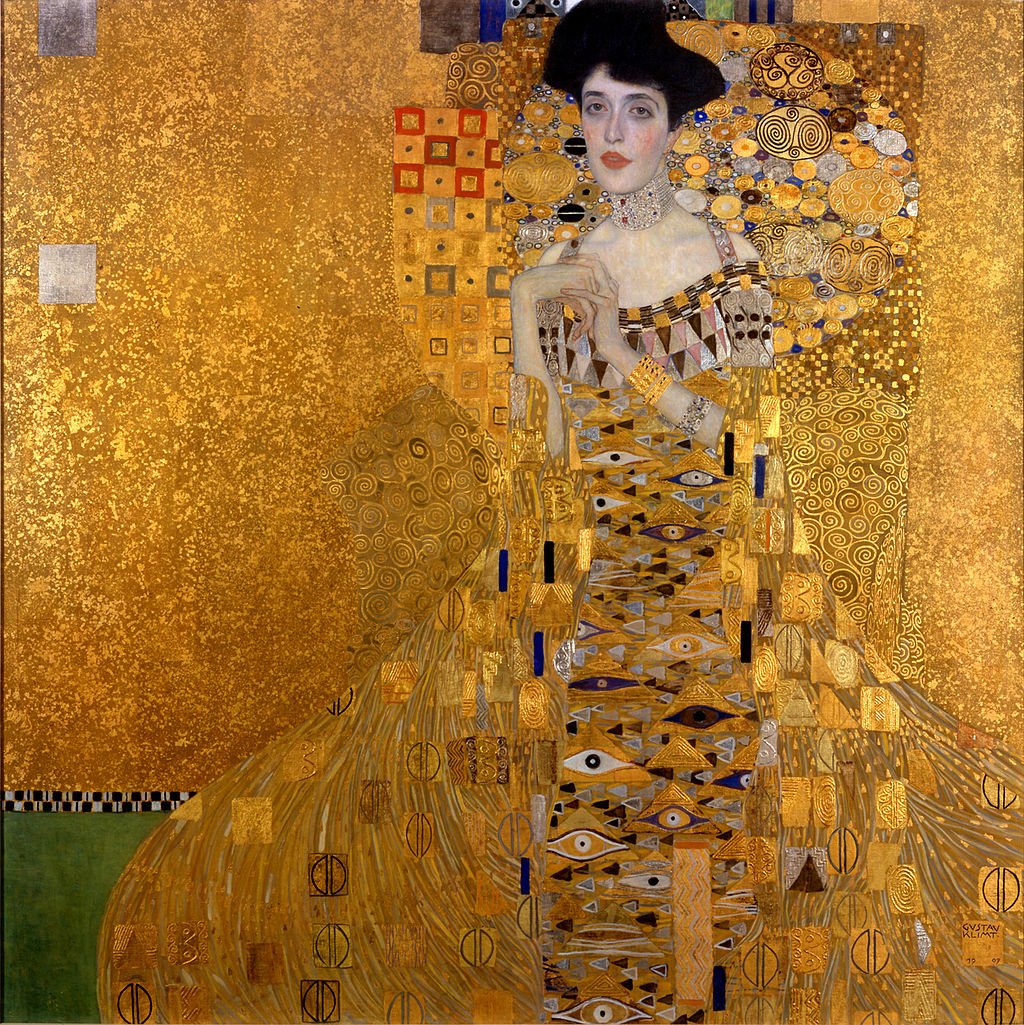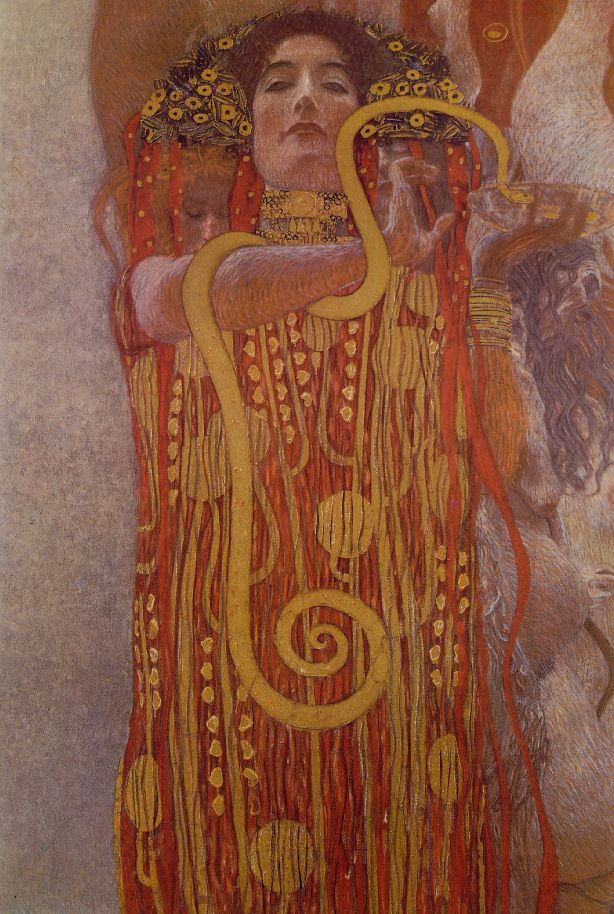46 Chapter 12 – Gustav Klimt
The Work of Gustav Klimt
Rachel Sluggett
Audio recording of this chapter is available here: https://drive.google.com/file/d/1yDn_OiqeWlZD3lTmrhFDiKWCZh3ah0Zi/view?usp=sharing


Gustav Klimt was born in July of 1862 as the second of seven children. Although they were poor for most of Gustav’s life, the whole family was known to be artistically talented[1]. His father had experience working with gold which may have led Gustav to using gold in his work later on. Klimt was enrolled in the Vienna School of Arts and Crafts in 1876, not long after he had dropped out of grade school. He was only fourteen. There he studied architectural painting until he was in his early twenties. Shortly after he began accepting commissions in order to earn a small wage for himself. With help from his only older sibling Ernst, the Klimt Brothers were able to make quite a name of themselves. They were well-known all-over Austria. Over the span of his life, Klimt had created a good life for himself. He was both loved and hated, as every good artist should be. He had helped revolutionize the way art was made, and the way art was viewed by both critics and the general public.

As one of the co-founders of the Secession Movement, Klimt had become a large player in the rebirth of art in Vienna. He had brought many ideas of foreign art back home from his travels. Klimt was known to have many influences on his work from around the world. Many say that his art reflects influences from Egyptian, Byzantine, Minoan, and Classical Greek art[2]. The goal of the Secession group was to provide a way for unconventional artists to have a platform to showcase their work. The group “did not encourage any particular style and thus Naturalists, Realists, and Symbolists all coexisted.”[3] The group was able to get government support and built an exhibition hall. They would be able to show off work of smaller and larger artists who may have had work that the public was not privy to. In Vienna there was a building put up which was designed by Joseph Maria Olbrich who was another founding member of the movement. It was completed in 1898 as a manifesto to the movement. Above the main doors of the exhibition hall read the words Der Zeit ihre Kunst der Kunst ihre Freiheit which translates to “to every age its art, to art its freedom”[4]. The Secession group stirred much controversy, one reason being that artists such as Klimt were already in a group of artists that would have an upper hand over the art industry. This group, known as the Association of Viennese Artists, was against any immigrant art, and soon Klimt and ten other artists left because of this. Klimt was a part of this group until 1908. Even though Klimt left the movement before many other artists, his art is often the face of the movement, namely his pieces Beethoven Frieze, Judith II, and Hope II.

Within his symbolism, Klimt would often use rectangles to represent the man, and circles to represent the woman. This can prominently be seen in The Kiss. It was symbolism such as this that showed the fact that Klimt had seen men and women as unique and different creatures. One of his larger works Beethoven Frieze was 112 feet long and had visually depicted Beethoven’s 9th Symphony. It was pieces like this that really showed how Klimt was able to use symbolism and artistic vision in his art. This work was also one of his more explicit paintings at the time, showing motifs of both love and sex. The sexual nature surrounding women in his work was believed to be inspired in part by French sculptor Auguste Rodin who had done many sculptures of naked people, often in erotic positions. Despite any negative criticism such as being called a misogynist, Klimt continued to focus his gaze on the female form. Many of his more erotic pieces had used symbolism more than naturalistic depictions. This is partially because at this time it was unusual to depict naked humans, especially if they are shown in an erotic nature. Even during the Secessionist Movement t, he was told he had to censor parts of his paintings. Due to this censorship, he had to find different ways to capture his vision using symbols. Thus, Klimt ended up being extremely well known for his use of symbolism in his artwork. Klimt would end up incorporating gold or colour into his work in order to censor more exotic natures of the art.

After his father and older brother passed, Klimt was the bearer of the family name, which he did well with[5]. He had kept to himself for the most part of his life because he had become so well known that he had the luxury of being selective with his clients. This led to only the most beautiful work being done during his Golden Phase. Many of Klimt’s pieces would be commissioned portraits of Vienna’s upper-class women. The wife of a wealthy Jewish banker is the subject of his work titled Portrait of Adele Bloch-Bauer I[6]. For this piece Klimt had used gold and silver leaf for the majority of the frame. This work painted in 1907 ended up being one of the most prominent works within Klimt’s Golden Phase due to the extreme use of gold leaves.[7] In a letter to his long-time partner Emilie Flöge, Klimt writes:
I have never painted a self portrait. I am less interested in myself as a subject for a painting than I am in other people, above all women… There is nothing special about me. I am a Painter who paints day after day from morning to night… Whoever wants to know something about me… ought to look carefully at my pictures.[8]
This shows that Klimt had put his heart and soul into every piece he did. To say that you must look at his art to know about him shows how each painting or drawing he did had a bit of him in it, and that each one is uniquely his.

Klimt’s Golden Phase was quite a success within the art world. He had already created a good name for himself but his work with gold leaf had sent him into the history books. Klimt was quite peculiar about his use of pure gold within his Golden Style. He had also visited Ravinia, Italy twice in the early 1900s so he could study mosaics. He ended up using gold as both additives to his paintings, as well as entire background details. The work most commonly associated with this period of Klimt’s includes The Kiss, which to many is considered better than the Mona Lisa. His work titled Pallas Athene from 1898 is believed to be the earliest piece in his Golden Phase. It shows the Greek goddess Athena in Golden armor. For many, the use of gold would seem to draw the mind to religious figures[9]. For Klimt, using gold around a woman was his way to show the almost supreme nature of women. “Klimt’s women are covered in gold, supreme creatures mounted into precious surfaces like jewels and icons of a new religion.”[10]

Prior to The Kiss, Klimt had used art to explore the life cycle, and how sex played a role within it[11]. In this group of paintings was a piece titled Medicine. When it was unveiled it was immediately criticized and deemed pornographic due to both the sight of female public hair, as well as female bodies intertwined. In response to his critics, Klimt titled a work To My Critics, later changed to Goldfish, which shows a woman naked from behind[12]. Klimt’s work within his Golden Phase was cemented in time. “When Klimt created his masterpiece at the height of the Viennese avant-garde and its psycho-sexual revolution, it was brazenly erotic, politically charged, and artistically revolutionary.”[13] Still, Klimt’s work would often be focused on the female form from a more sensual viewpoint. Art critic Ludwig Hevesi had described the work during the Golden Phase, comparing his work with gold to “zebra stripes flashing like lightning, tongues of flame… vine tendrils, smoothly linked chains, flowing veils, tender nets.”[14] Gold was no longer the subject of interest of Klimt after about 1911, when he instead began using bright colours and patterns.
Although in many cases Klimt’s work with gold was facing rejection, some art critics had noted that the use of gold had shown a great resemblance to the original medieval mosaics. As a prominent art critic, Hevesi had noticed this, and noted that he felt immersed in their painting due to the glittering from the gold. In the end, Klimt’s paintings would be some of the most valuable individual works of art. After his death, many of his pieces sold for tens of millions of dollars, his work Adele Bloch-Bauer I sold for $135 million in 2006[15]. Many works from his Golden Phase are prominent in Viennese culture in the modern day, being on everything from life sized replicas to keychains to printed t-shirts. Although Klimt would have known his impact on Viennese culture during his lifetime, he could not have known the legacy he would leave behind.

Bibliography
Bailey, Colin. Gustav Klimt: Modernism in the Making. New York: Harry N. Abrams Inc., 2001.
di Stefano, Eva. Gustav Klimt: Art Nouveau Visionary. New York: Sterling, 2008.
Gotthardt, Alexxa. “Klimt’s Iconic “Kiss” Sparked a Sexual Revolution in Art” Artsy, May 8, 2019. https://tinyurl.com/y23d4u4g.
Fliedl, Gottfried. Gustav Klimt, 1862-1918: The World in Female Form. New York: Taschen. 1998.
Miller, Hannah. “A Partner in Their Suffering: Gustav Klimt’s Empowered Figure in Hope II.” All Theses and Dissertations, 2017. https://doi.org/10.1093/benz/9780199773787.article.b00099386
Moffat, Charles. “Biography of a Symbolist Painter.” Gustav Klimt – Symbolist Painter – The Art History Archive, 2008. https://tinyurl.com/6wngvyt.
Neret, Gilles. Gustav Klimt: 1862-1918. Germany: Taschen, 2005.
Richman-Abdou, Kelly. “The Splendid History of Gustav Klimt’s Glistening “Golden Phase””. My Modern Met, September 2018. https://tinyurl.com/y2txe84f.
- Moffat, Charles. Biography of a Symbolist Painter: Gustav Klimt - Symbolist Painter – (The Art History Archive, 2008) ↵
- Moffat. Biography of a Symbolist Painter. ↵
- Moffat. Biography of a Symbolist Painter. ↵
- Gotthardt, Alexxa. Klimt’s Iconic “Kiss” Sparked a Sexual Revolution in Art. (Artsy, May 8, 2019). ↵
- Moffat. Biography of a Symbolist Painter. ↵
- Gotthardt. Klimt’s Iconic “Kiss” Sparked a Sexual Revolution in Art. ↵
- Gotthardt. ↵
- Richman-Abdou, Kelly. The Splendid History of Gustav Klimt’s Glistening “Golden Phase”. (My Modern Met, September 2018) ↵
- Gotthardt. ↵
- di Stefano, Eva. Gustav Klimt: Art Nouveau Visionary. (New York: Sterling, 2008). ↵
- Gotthardt. Klimt’s Iconic “Kiss” Sparked a Sexual Revolution in Art. ↵
- Gotthardt. ↵
- Gotthardt. ↵
- Gotthardt. Klimt’s Iconic “Kiss” Sparked a Sexual Revolution in Art. ↵
- Moffat. Biography of a Symbolist Painter. ↵

